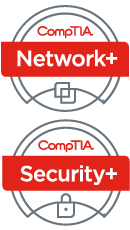CompTIA Network+ / Security+ Certification Training Course
CompTIA Network+ / Security+
| Course Number: |
#CED-398 |
| Course Length: |
10 days |
| Number of Exams: |
2 |
| Certifications: |
CompTIA Network+
CompTIA Security+ |
Grants (discounts) are available for multiple students for the same or different courses. |
Online Self-Study

- 80 hours
- 32 Course Videos
- CompTIA Official Courseware
- CompTIA Official Video
- CompTIA Official Labs
- Lifetime access to Courseware
- Videos and Labs are available for 1 year from date of redemption
- Apply Cost to Instructor-led Training of Same Course
Instant Quote
Instructor-Led
- Certified Instructor
- Includes all course materials

CompTIA Summer Sale
Use code SAVE15JULY in checkout to save 15% on A+, Network+, Security+.
Limited time.
Can't travel or you want to stay with your family or business. No problem!
Stay in your own city and save the additional expenses of roundtrip airfare, lodging, transportation, and meals and receive the same great instruction live from our instructors in our Live Instructor-Led Remote Classroom Training.
Remote Classroom Training
Our Remote Classroom Training is a live class with students observing the instructor and listening through your computer speakers.
You will see the instructor's computer, slides, notes, etc., just like in the classroom. You will be following along, doing work, labs, and individual assignments.

CED Solutions Rewards Points Program
"The Network+ instructor was very knowledgeable and I felt he knew what was needed to get our class to pass this course. This was my first boot camp, but with the experience that I have had I will definitely refer my associates to CED Solutions." -T. Riley, Milford, OH
The CompTIA Network+ (Exam N10-008) certification ensures that the successful candidate has the important knowledge and skills necessary to manage, maintain, troubleshoot, install, operate and configure basic network infrastructure, describe networking technologies, basic design principles, and adhere to wiring standards and use testing tools.
CompTIA Security+ (Exam SY0-701) is the primary course you will need to take if your job responsibilities include securing network services, network devices, and network traffic. It is also the main course you will take to prepare for the CompTIA Security+ examination. In this course, you'll build on your knowledge and professional experience with computer hardware, operating systems, and networks as you acquire the specific skills required to implement basic security services on any type of computer network.
Network+ certification
CompTIA Network+ (Exam N10-008) helps develop a career in IT infrastructure covering troubleshooting, configuring, and managing networks.
CompTIA Network+ validates the technical skills needed to securely establish, maintain and troubleshoot the essential networks that businesses rely on.
Unlike other vendor-specific networking certifications, CompTIA Network+ prepares candidates to support networks on any platform. CompTIA Network+ is the only certification that covers the specific skills that network professionals need. Other certifications are so broad, they don't cover the hands-on skills and precise knowledge needed in today's networking environments.
CompTIA Network+ features flexible training options including self-paced learning, live online training, custom training and labs to advance the career development of IT professionals in network administration.
What Skills Will You Learn?
Networking Fundamentals
Explain basic networking concepts including network services, physical connections, topologies and architecture, and cloud connectivity.
Network Implementations
Explain routing technologies and networking devices; deploy ethernet solutions and configure wireless technologies.
Network Operations
Monitor and optimize networks to ensure business continuity.
Network Security
Explain security concepts and network attacks in order to harden networks against threats.
Network Troubleshooting
Troubleshoot common cable, connectivity, and software issues related to networking.
Jobs that use Network+
- Junior Network Administrator
- Datacenter Support Technician
- Network Engineer
- System Administrator
- NOC Technician
- Telecommunications Technician
- Cable Technician
Course Outline
1.0 Networking Fundamentals
Compare and contrast the Open Systems Interconnection (OSI) model layers and encapsulation concepts.
- OSI model
- Data encapsulation and decapsulation within the OSI model context
Explain the characteristics of network topologies and network types.
- Mesh
- Star/hub-and-spoke
- Bus
- Ring
- Hybrid
- Network types and characteristics
- Service-related entry point
- Virtual network concepts
- Provider links
Summarize the types of cables and connectors and explain which is the appropriate type for a solution.
- Copper
- Fiber
- Connector types
- Cable management
- Ethernet standards
Given a scenario, configure a subnet and use appropriate IP addressing schemes.
- Public vs. private
- IPv4 vs. IPv6
- IPv4 subnetting
- IPv6 concepts
- Virtual IP (VIP)
- Subinterfaces
Explain common ports and protocols, their application, and encrypted alternatives.
- File Transfer Protocol (FTP)
- Secure Shell (SSH)
- Secure File Transfer Protocol (SFTP)
- Telnet
- Simple Mail Transfer Protocol (SMTP)
- Domain Name System (DNS)
- Dynamic Host Configuration Protocol (DHCP)
- Trivial File Transfer Protocol (TFTP)
- Hypertext Transfer Protocol (HTTP)
- Post Office Protocol v3 (POP3)
- Network Time Protocol (NTP)
- Internet Message Access Protocol (IMAP)
- Simple Network Management Protocol (SNMP)
- Lightweight Directory Access Protocol (LDAP)
- Hypertext Transfer Protocol Secure (HTTPS) [Secure Sockets Layer (SSL)]
- HTTPS [Transport Layer Security (TLS)]
- Server Message Block (SMB)
- Syslog
- SMTP TLS
- Lightweight Directory Access Protocol (over SSL) (LDAPS)
- IMAP over SSL
- POP3 over SSL
- Structured Query Language (SQL) Server
- SQLnet
- MySQL
- Remote Desktop Protocol (RDP)
- Session Initiation Protocol (SIP)
- IP protocol types
- Connectionless vs. connection-oriented
Explain the use and purpose of network services.
Explain basic corporate and datacenter network architecture.
- Three-tiered
- Software-defined networking
- Spine and leaf
- Traffic flows
- Branch office vs. on-premises datacenter vs. colocation
- Storage area networks
Summarize cloud concepts and connectivity options.
- Deployment models
- Service models
- Infrastructure as code
- Connectivity options
- Multitenancy
- Elasticity
- Scalability
- Security implications
2.0 Network Implementations
Compare and contrast various devices, their features, and their appropriate placement on the network.
- Networking devices
- Networked devices
Compare and contrast routing technologies and bandwidth management concepts.
- Routing
- Bandwidth management
Given a scenario, configure and deploy common Ethernet switching features.
- Data virtual local area network (VLAN)
- Voice VLAN
- Port configurations
- Media access control (MAC) address tables
- Power over Ethernet (PoE)/ Power over Ethernet plus (PoE+)
- Spanning Tree Protocol
- Carrier-sense multiple access with collision detection (CSMA/CD)
- Address Resolution Protocol (ARP)
- Neighbor Discovery Protocol
Given a scenario, install and configure the appropriate wireless standards and technologies.
- 802.11 standards
- Frequencies and range
- Channels
- Channel bonding
- Service set identifier (SSID)
- Antenna types
- Encryption standards
- Cellular technologies
- Multiple input, multiple output (MIMO) and multi-user MIMO (MU-MIMO)
3.0 Network Operations
Given a scenario, use the appropriate statistics and sensors to ensure network availability.
- Performance metrics/sensors
- SNMP
- Network device logs
- Interface statistics/status
- Interface errors or alerts
- Environmental factors and sensors
- Baselines
- NetFlow data
- Uptime/downtime
Explain the purpose of organizational documents and policies.
- Plans and procedures
- Hardening and security policies
- Common documentation
- Common agreements
Explain high availability and disaster recovery concepts and summarize which is the best solution.
- Load balancing
- Multipathing
- Network interface card (NIC) teaming
- Redundant hardware/clusters
- Facilities and infrastructure support
- Redundancy and high availability (HA) concepts
- Network device backup/restore
4.0 Network Security
Explain common security concepts.
- Confidentiality, integrity, availability (CIA)
- Threats
- Vulnerabilities
- Exploits
- Least privilege
- Role-based access
- Zero Trust
- Defense in depth
- Authentication methods
- Risk Management
- Security information and event management (SIEM)
Compare and contrast common types of attacks.
- Technology-based
- Human and environmental
Given a scenario, apply network hardening techniques.
- Best practices
- Wireless security
- IoT access considerations
Compare and contrast remote access methods and security implications.
- Site-to-site VPN
- Client-to-site VPN
- Remote desktop connection
- Remote desktop gateway
- SSH
- Virtual network computing (VNC)
- Virtual desktop
- Authentication and authorization considerations
- In-band vs. out-of-band management
Explain the importance of physical security.
- Detection methods
- Prevention methods
- Asset disposal
5.0 Network Troubleshooting
Explain the network troubleshooting methodology.
- Identify the problem
- Establish a theory of probable cause
- Test the theory to determine the cause
- Establish a plan of action to resolve the problem and identify potential effects
- Implement the solution or escalate as necessary
- Verify full system functionality and, if applicable, implement preventive measures
- Document findings, actions, outcomes, and lessons learned
Given a scenario, troubleshoot common cable connectivity issues and select the appropriate tools.
- Specifications and limitations
- Cable considerations
- Cable application
- Common issues
- Common tools
Given a scenario, use the appropriate network software tools and commands.
- Software tools
- Command line tool
- Basic network platform commands
Given a scenario, troubleshoot common wireless connectivity issues.
- Specifications and limitations
- Considerations
- Common issues
Given a scenario, troubleshoot general networking issues.
- Considerations
- Common issues
[ back to top ]
Security+ certification
CompTIA Security+ (SY0-701) is a global certification that validates the baseline skills necessary to perform core security functions and pursue an IT security career.
Open the Door to Your Cybersecurity Career
Launch a successful cybersecurity career
Develop a core foundation of essential skills, paving the way for a fulfilling career. More job roles use Security+ for baseline cybersecurity skills than any other certification in the industry.
Assess on-the-job skills
Security+ is the most widely adopted ISO/ANSI-accredited early career cybersecurity certification on the market with hands-on, performance-based questions on the certification exam. These practical questions assess your ability to effectively problem solve in real-life situations and demonstrate your expertise to potential employers immediately.
Embrace the latest trends
Understand and use the most recent advancements in cybersecurity technology, terms, techniques, and tools. By acquiring early career skills in the latest trends such as automation, zero trust, risk analysis, operational technology, and IoT, you will be well-equipped to excel in the ever-evolving cybersecurity landscape.
Exam SY0-701
The new CompTIA Security+ represents the latest and greatest in cybersecurity, covering the most in-demand skills related to current threats, automation, zero trust, IoT, risk - and more. Once certified, you'll understand the core skills needed to succeed on the job - and employers will notice too. The Security+ exam verifies you have the knowledge and skills required to:
- Assess the security posture of an enterprise environment and recommend and implement appropriate security solutions.
- Monitor and secure hybrid environments, including cloud, mobile, Internet of Things (IoT), and operational technology.
- Operate with an awareness of applicable regulations and policies, including principles of governance, risk, and compliance.
- Identify, analyze, and respond to security events and incidents.
CompTIA Security+ is compliant with ISO 17024 standards and approved by the U.S. DoD to meet directive 8140/8570.01-M requirements. Regulators and government rely on ANSI accreditation because it provides confidence and trust in the outputs of an accredited program. Over 2.3 million CompTIA ISO/ANSI-accredited exams have been delivered since January 1, 2011.
What Skills Will You Learn?
General Security Concepts
Includes key cybersecurity terminology and concepts up front to provide a foundation for security controls discussed throughout the exam.
Threats, Vulnerabilities & Mitigations
Focuses on responding to common threats, cyberattacks, vulnerabilities, and security incidents and appropriate mitigation techniques to monitor and secure hybrid environments.
Security Architecture
Includes security implications of different architecture models, principles of securing enterprise infrastructure, and strategies to protect data.
Security Operations
Includes applying and enhancing security and vulnerability management techniques, as well as security implications of proper hardware, software, and data management.
Security Program Management & Oversight
Updated to better reflect the reporting and communication skills required for Security+ job roles relating to governance, risk management, compliance, assessment, and security awareness.
Jobs You Can Land With CompTIA Security+
- Cloud Penetration Tester
- Network Security Operations
- Penetration Tester
- Network Security Analyst
- Web App Penetration Tester
- Security Architect
Course Content
1.0 General Security Concepts
Compare and contrast various types of security controls.
Summarize fundamental security concepts.
- Confidentiality, Integrity, and Availability (CIA)
- Non-repudiation
- Authentication, Authorization, and Accounting (AAA)
- Gap analysis
- Zero Trust
- Physical security
- Deception and disruption technology
Explain the importance of change management processes and the impact to security.
- Business processes impacting security operation
- Technical implications
- Documentation
- Version control
Explain the importance of using appropriate cryptographic solutions.
- Public key infrastructure (PKI)
- Encryption
- Tools
- Obfuscation
- Steganography
- Tokenization
- Data masking
- Hashing
- Salting
- Digital signatures
- Key stretching
- Blockchain
- Open public ledger
- Certificates
2.0 Threats, Vulnerabilities, and Mitigations
Compare and contrast common threat actors and motivations.
- Threat actors
- Attributes of actors
- Motivations
Explain common threat vectors and attack surfaces.
- Message-based
- Email
- Short Message Service (SMS)
- Instant messaging (IM)
- Image-based
- File-based
- Voice call
- Removable device
- Vulnerable software
- Unsupported systems and applications
- Unsecure networks
- Open service ports
- Default credentials
- Supply chain
- Human vectors/social engineering
Explain various types of vulnerabilities.
- Application
- Operating system (OS)-based
- Web-based
- Hardware
- Virtualization
- Cloud-specific
- Supply chain
- Cryptographic
- Misconfiguration
- Mobile device
- Zero-day
Given a scenario, analyze indicators of malicious activity.
- Malware attacks
- Physical attacks
- Network attacks
- Application attacks
- Cryptographic attacks
- Password attacks
- Indicators
Explain the purpose of mitigation techniques used to secure the enterprise.
- Segmentation
- Access control
- Application allow list
- Isolation
- Patching
- Encryption
- Monitoring
- Least privilege
- Configuration enforcement
- Decommissioning
- Hardening techniques
3.0 Security Architecture
Compare and contrast security implications of different architecture models.
- Architecture and infrastructure concepts
- Considerations
Given a scenario, apply security principles to secure enterprise infrastructure.
- Infrastructure considerations
- Secure communication/access
- Selection of effective controls
Compare and contrast concepts and strategies to protect data.
- Data types
- Data classifications
- General data considerations
- Methods to secure data
Explain the importance of resilience and recovery in security architecture.
- High availability
- Site considerations
- Platform diversity
- Multi-cloud systems
- Continuity of operations
- Capacity planning
- Testing
- Backups
- Power
4.0 Security Operations
Given a scenario, apply common security techniques to computing resources.
- Secure baselines
- Hardening targets
- Wireless devices
- Mobile solutions
- Wireless security settings
- Application security
- Sandboxing
- Monitoring
Explain the security implications of proper hardware, software, and data asset management.
- Acquisition/procurement process
- Assignment/accounting
- Monitoring/asset tracking
- Disposal/decommissioning
Explain various activities associated with vulnerability management.
- Identification methods
- Analysis
- Vulnerability response and remediation
- Validation of remediation
- Reporting
Explain security alerting and monitoring concepts and tools.
- Monitoring computing resources
- Activities
- Tools
Given a scenario, modify enterprise capabilities to enhance security.
- Firewall
- IDS/IPS
- Web filter
- Operating system security
- Implementation of secure protocols
- DNS filtering
- Email security
- File integrity monitoring
- DLP
- Network access control (NAC)
- Endpoint detection and response (EDR)/extended detection and response (XDR)
- User behavior analytics
Given a scenario, implement and maintain identity and access management.
- Provisioning/de-provisioning user accounts
- Permission assignments and implications
- Identity proofing
- Federation
- Single sign-on (SSO)
- Interoperability
- Attestation
- Access controls
- Multifactor authentication
- Password concepts
- Privileged access management tools
Explain the importance of automation and orchestration related to secure operations.
- Use cases of automation and scripting
- Benefits
- Other considerations
Explain appropriate incident response activities.
- Process
- Training
- Testing
- Root cause analysis
- Threat hunting
- Digital forensics
Given a scenario, use data sources to support an investigation.
5.0 Security Program Management and Oversight
Summarize elements of effective security governance.
- Guidelines
- Policies
- Standards
- Procedures
- External considerations
- Monitoring and revision
- Types of governance structures
- Roles and responsibilities for systems and data
Explain elements of the risk management process.
- Risk identification
- Risk assessment
- Risk analysis
- Risk register
- Risk tolerance
- Risk appetite
- Risk management strategies
- Risk reporting
- Business impact analysis
Explain the processes associated with third-party risk assessment and management.
- Vendor assessment
- Vendor selection
- Agreement types
- Vendor monitoring
- Questionnaires
- Rules of engagement
Summarize elements of effective security compliance.
- Compliance reporting
- Consequences of non-compliance
- Compliance monitoring
- Privacy
Explain types and purposes of audits and assessments.
- Attestation
- Internal
- External
- Penetration testing
Given a scenario, implement security awareness practices.
- Phishing
- Anomalous behavior recognition
- User guidance and training
- Reporting and monitoring
- Development
- Execution
[ back to top ]
CED Solutions is your best choice for CompTIA Network Security,
CompTIA Network Security training,
CompTIA Network Security certification,
CompTIA Network Security boot camp,
CompTIA Network Security certification training,
CompTIA Network Security certification course,
CompTIA Network Security course,
CompTIA Network Security class.
|


Follow CED